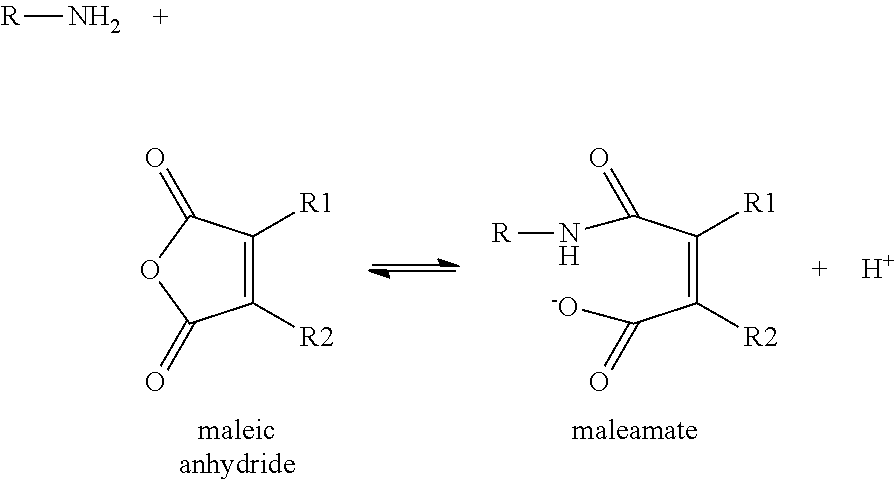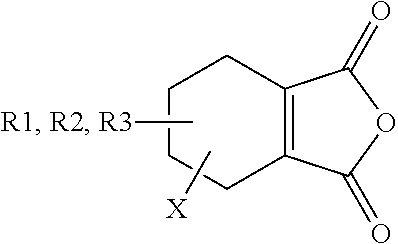Disubstituted Maleic Anhydrides with Altered Kinetics of Ring Closure
a technology of ring closure and maleamate, which is applied in the direction of sugar derivatives, organic chemistry, etc., can solve the problems of dialkyl-substituted maleamates' half-life being too energetically favorable, and amide cleavage being too rapid, so as to increase the acidity of the carboxyl group and reduce the rate of ring closure reaction
- Summary
- Abstract
- Description
- Claims
- Application Information
AI Technical Summary
Benefits of technology
Problems solved by technology
Method used
Image
Examples
example 1
Cyclohexene-CDM (CycHex-CDM) Derivative
[0080]
A) 1,2,4-tricarboxy-1-cyclohexene 2
[0081]1,2,4-tricarbomethoxy-1-cyclohexene 1 (465 mg, 1.8 mmol (Claude et al., J. Org. Chem. 2004, 69, 757-764)) was refluxed in a mixture of EtOH (10 mL) and 2N KOH (4 mL) for 1 h. EtOH was removed by rotary evaporation, The residue was diluted with H2O (20 mL), washed 3 times with DCM, acidified to pH=1 with 10% HCl and product 2 was extracted with EtOAc. The extract was dried using Na2SO4 as a drying agent, concentrated, and dried in vacuo. Yield 296 mg (73%). 1H-NMR (DMSO-d6): 1.6-1.64 m (1H); 1.87-2.00 m (1H); 2.20-2.40 m (5H); 2.42-2.60 m (1H).
B) CycHex-CDM-Cl 3
[0082]Triacid 2 (50 mg, 0.234 mmol) was suspended in dichloroethane (10 mL), treated with oxalyl chloride (0.3 mL, 3.4 mmol), and stirred for 24 h at 20° C. All volatiles were removed by rotary evaporation at 25° C. and the residue was dried in vacuo for 4 h.
C) CycHex-CDM-PEG12 4
[0083]At 0° C., a solution of PEG12 amine (112 mg, 0.2 mmol) and...
example 2
Benzo-CDM Derivatives
[0084]
A) (5E,7E)-5, 7-undecandienoic acid 6
[0085]LiBr (1.5 M, 56 mL, 84 mmol) was added to a solution of (4-carboxybutyl)triphenylphosphonium bromide 5 (11.08 g, 25 mmol) in THF (45 mL) and cooled to −75° C. While stirring, PhLi (1.8 M in dibutyl ether, 31 mL, 55 mmol) was added dropwise, keeping the temperature of the reaction mixture between −75° C. and −70° C. The cooling bath was removed and the reaction mixture was gradually warmed over 30 min to 25° C. The solution was then cooled to −75° C. and (2E)-2-pentenal (2.103 g, 25 mmol) was added via syringe. The reaction mixture was stirred for 5 min at −75° C. and PhLi (15 mL, 27 mmol) was added over a period of 30 min. The reaction mixture was then stirred for 30 min at −75° C., warmed to 25° C. for 30 min, and then cooled again to −75° C. Hydrogen chloride (1M solution in Et2O, 28 mL, 28 mmol) was added. After 5 min, t-BuOK (3.36 g, 30 mmol) was added. The reaction mixture was allowed to warm to 25° C., stirr...
example 3
(Meta-Ar)-CDM Derivatives
[0090]
A). Methyl 3-(cyanomethyl)benzoate 15
[0091]To a stirring aqueous solution (60 mL) of potassium cyanide (3.62 g, 55.7 mmol) at 65° C. was added dropwise methyl 3-(bromomethyl)benzoate 14 (10.2 g, 44.5 mmol) in absolute ethanol (50 mL) over a period of 0.5 h. After addition, the reaction was stirred for 1.5 h at 65° C. The solution was then diluted with absolute ethanol (500 mL), cooled on ice bath, filtered, and concentrated with a rotary evaporator. The crude was treated with chloroform (350 mL), dried over MgSO4, filtered, concentrated, and used without further purification. Yield 6.3 g (81%). 1H-NMR (CDCl3): 3.81 br s (2H, CH2), 3.93 s (3H, CH3); 7.45-7.51 m (1H, CH), 7.53-7.58 m (1H, CH), 7.99-8.04 m (2H, CH).
B) 3-Carboxymethylbenzoic Acid 16
[0092]Methyl 3-(cyanomethyl)benzoate 15 (6.3 g, 36.0 mmol) was treated with H2SO4 (40%, 108 mL) and refluxed for 3 h at 160° C. The reaction mixture was then slowly cooled, diluted with cold H2O (108 mL), and fi...
PUM
| Property | Measurement | Unit |
|---|---|---|
| pH | aaaaa | aaaaa |
| pH | aaaaa | aaaaa |
| pH | aaaaa | aaaaa |
Abstract
Description
Claims
Application Information
 Login to View More
Login to View More - R&D
- Intellectual Property
- Life Sciences
- Materials
- Tech Scout
- Unparalleled Data Quality
- Higher Quality Content
- 60% Fewer Hallucinations
Browse by: Latest US Patents, China's latest patents, Technical Efficacy Thesaurus, Application Domain, Technology Topic, Popular Technical Reports.
© 2025 PatSnap. All rights reserved.Legal|Privacy policy|Modern Slavery Act Transparency Statement|Sitemap|About US| Contact US: help@patsnap.com



